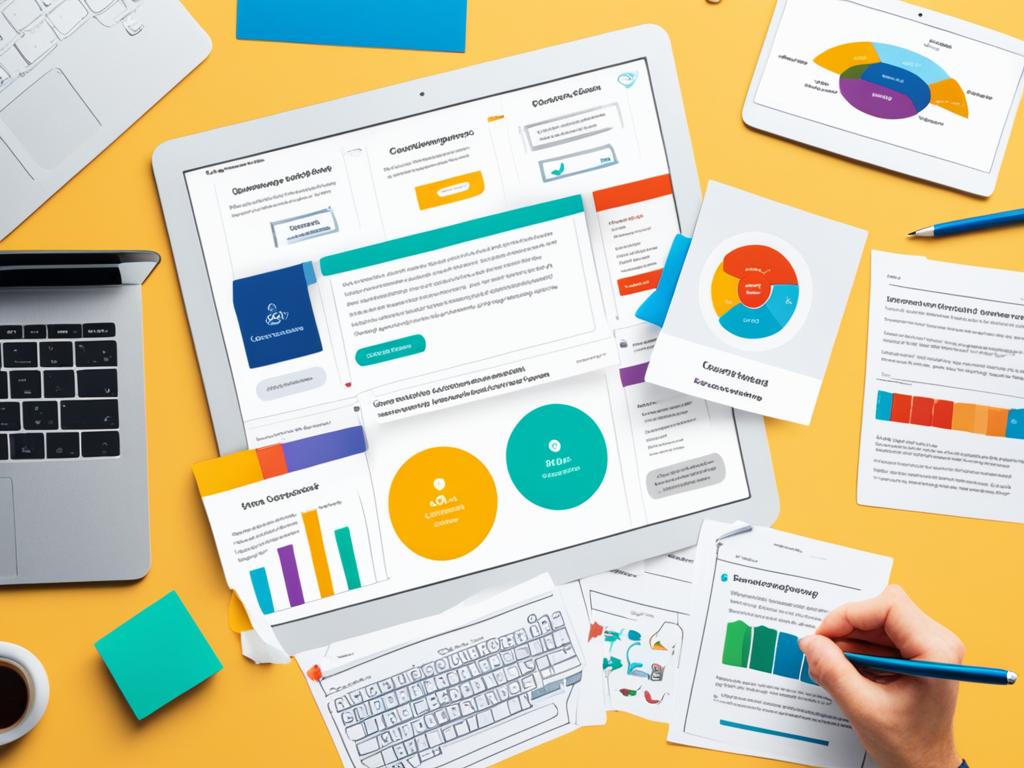
What is Microlearning?
Microlearning is a new way to learn that breaks content into short, focused bits. It’s different from long, traditional training sessions. It uses bite-sized lessons that grab your attention and are easy to understand. This method helps you remember more and get the help you need right when you need it. It’s great for work training, personal growth, and learning throughout your life.
This approach meets the needs of today’s learners who want quick, easy-to-get information. It turns hard topics into “learning nuggets” or “micro-lessons.” This way, it fits the short attention spans and how people like to learn today. It’s perfect for mobile learning, letting you learn new things anywhere, anytime.

It uses spaced repetition and just-in-time learning to make learning stick. It shows you important stuff in short, regular bits to help you remember and use it better. Plus, you can get the info you need right away, which helps with your work and personal growth.
Defining Microlearning
It is a new way to learn and grow that breaks content into small, easy pieces. These pieces, called “learning nuggets,” are 2 to 15 minutes long. They help learners get information quickly and well.
Bite-sized Learning Chunks
The main idea of microlearning is to split big topics into smaller, bite-sized learning bits. These micro-lessons focus on one thing at a time. This makes it easier for learners to understand and remember what they learn.
Learner-centric Approach
It puts the learner first, offering mobile learning that learners can use whenever they want. They can learn on their phones or tablets, at their own speed. This makes learning fit the learner’s life and helps them stay interested and engaged.

Using microlearning, companies can make learning more dynamic and flexible. This new way of learning is changing how we learn and remember things. It’s making corporate training more efficient and effective for the future.
Microlearning: The Future of Corporate Training
In today’s fast-paced world, companies are looking for new ways to keep their workers sharp and productive. It is a key solution, offering a new way to train that’s changing how we learn at work.
It gives us short, focused lessons that fit today’s learners perfectly. Workers often need quick access to info to do their jobs well. It gives them that, making learning easy and fun.
This method is great for corporate training. It keeps employees engaged and helps them remember what they learn. It’s also super flexible, making it perfect for teams spread out across different locations or working from home.
| Key Features of Microlearning for Corporate Training | Benefits |
|---|---|
| Just-in-time training Performance support Bite-sized content Multi-format delivery | Increased employee engagement and retention Improved knowledge transfer and application Flexible and accessible learning experiences Reduced training costs and time |
As companies change, microlearning is becoming more important in training. It offers targeted, personalized learning that helps employees do their best. This leads to success for businesses in the digital world.

Benefits of Microlearning
It has many benefits for both learners and companies. It delivers content in short, engaging pieces. This makes it easier to increase learner engagement and improve knowledge retention than long training sessions. It’s also flexible and accessible, making learning better and more effective.
Increased Engagement and Retention
Microlearning fits today’s learner’s short attention spans well. It keeps learners focused and interested with concise, relevant info. This leads to better improved retention of the material, helping learners apply what they’ve learned.
Flexible and Accessible
It lets learners get content anytime, anywhere, at their own speed. This flexible learning fits easily into their busy lives. It makes learning convenient, making the whole experience better.

Using microlearning, companies can create more effective training. It helps build a culture of continuous learning. This leads to better performance and productivity in the workforce.
Key Characteristics of Effective Microlearning
In corporate training, microlearning shines by offering concise content and focused learning. These short lessons aim at specific goals, cutting out unnecessary info. They give learners only what they need to know.
Good microlearning grabs the learner’s attention and helps them remember what they learn. It uses different formats like videos, infographics, quizzes, and interactive games. This way, it meets various learning styles and keeps learners interested.
Concise and Focused Content
Microlearning has a clear focus, targeting one goal or skill per module. This concise content method means learners don’t waste time on unimportant info. They can quickly get the knowledge they need.
Multi-format Delivery
To keep learners engaged in today’s digital world, using a mix of formats is key. Microlearning offers a variety of content types, like videos, infographics, quizzes, and simulations. This makes learning fun and suits different learning styles, keeping learners hooked.
By combining concise content, focused learning, and multi-format delivery, microlearning helps learners quickly gain knowledge and skills. This leads to better performance and productivity at work.

Microlearning in Action
It is a great way to train employees and help them grow. It breaks down hard topics into small, easy lessons. This makes learning quick and helps people remember more. Let’s look at some real examples and studies that show how powerful this method is.
In the sales world, a top tech company uses microlearning to keep its sales teams sharp. They can watch short videos or do quizzes on their phones. This helps them know more about products and sell better, making customers happier.
Healthcare is another area where microlearning shines. A big hospital network uses it to help nurses quickly. Nurses can check out guides, drug info, and tips on their devices. This has made nurses more engaged and helped patients get better care.
| Industry | Microlearning Application | Key Outcomes |
|---|---|---|
| Technology | Sales team training on product features | Improved sales performance, increased customer satisfaction |
| Healthcare | Nursing staff support on procedures, medication, and patient care | Increased employee engagement, improved patient outcomes |
These examples show how microlearning works well in different fields. It helps employees get the skills they need to do well. This leads to success for the company.

Integrating Microlearning into Your Learning Strategy
Adding microlearning implementation to a company’s learning plan needs careful thought and action. Start by doing a detailed learning needs analysis. This helps find out where microlearning can really help.
Identifying Learning Needs
Look at what the company wants to achieve, what learners like, and their current skills. This helps L&D experts see where microlearning can make a big difference. This deep look is key to making sure the content curation and content creation are spot-on.
Curating and Creating Content
After figuring out what learners need, it’s time to make microlearning content that fits the company’s goals and speaks to the audience. This means picking or making short, fun learning bits that learners can easily find and use when they want.
For curating content, L&D teams can use what they already have, like expert knowledge, best practices, or content from users. Creating new microlearning content means knowing what learners like, how they learn best, and what they aim to achieve.
By smartly adding microlearning implementation to their learning setup, companies can boost the success of their training. This leads to more engaged learners, better retention, and improved performance.

Microlearning: Trends and Future Outlook
The demand for learning that’s efficient, engaging, and easy to get to is growing fast. This makes the future of microlearning look very promising. New tech like artificial intelligence, virtual reality, and learning algorithms that get to know you are making microlearning better. They’re making it more flexible, fun, and suited to what each learner needs.
With more people working from home or in hybrid setups, microlearning is set to become even more popular. Companies want to keep their teams learning and improving, no matter where they are. This will lead to new microlearning tech and platforms, opening up more ways to learn.
Here are some key microlearning trends and what’s coming next:
- Personalized learning algorithms that change what you see and how you see it based on what you like and need
- Immersive learning experiences thanks to virtual and augmented reality
- Seamless integration of microlearning into your work, thanks to better learning systems
- Increased use of artificial intelligence for picking content, suggesting it, and helping you on the job
- Greater emphasis on mobile-first design for learning that fits into your busy life
As microlearning keeps getting better, companies that jump on these trends will offer learning that’s more effective, fun, and impactful. This will help their employees do better and help the business succeed.
| Microlearning Trend | Description |
|---|---|
| Personalized Learning Algorithms | Adaptive content and delivery based on individual learner preferences and needs |
| Immersive Learning Experiences | Virtual and augmented reality technologies for more engaging and realistic learning |
| Seamless Integration | Embedded microlearning within the flow of work, enabled by advancements in enterprise learning management systems |
| Artificial Intelligence | AI-powered content curation, recommendation, and real-time performance support |
| Mobile-first Design | Responsive learning experiences optimized for on-the-go modern learners |
Conclusion
Microlearning has become a key way to learn and train, changing how we get and use knowledge. It breaks content into small, easy-to-digest pieces. This makes learning more engaging, helps keep information in our minds, and offers timely support. These are key in our fast, digital world.
As companies see the value in microlearning, it’s set to become even more important for training and learning throughout life. It can give learners exactly what they need, when they need it. This makes microlearning perfect for today’s fast-changing world.
To sum up, it is a full solution to the problems of old training methods. It lets people and companies reach their full potential with learning that’s engaging, flexible, and effective.
FAQ
What is microlearning?
It is a new way to learn that breaks content into short, focused pieces. It’s different from long, traditional training. It uses bite-sized lessons that are engaging and easy to understand.
What are the key characteristics of effective microlearning?
Good microlearning is short and focused. It aims to teach specific skills without extra info. It uses various formats like videos and quizzes to keep learners interested.
How can microlearning benefit organizations?
Microlearning has many benefits for both learners and companies. It makes learning fun and helps people remember more. It also lets learners learn whenever they want, making it more flexible.
How can organizations integrate microlearning into their learning strategy?
To add microlearning to their strategy, companies need to know what their learners need. They should create relevant content that fits their goals and what learners like. This way, microlearning can make training more effective.
What are the current trends and future outlook for microlearning?
Microlearning is getting more popular as people want learning to be efficient and fun. New tech like AI and VR will make it even better. With more people working remotely, it will help keep everyone up to speed.


